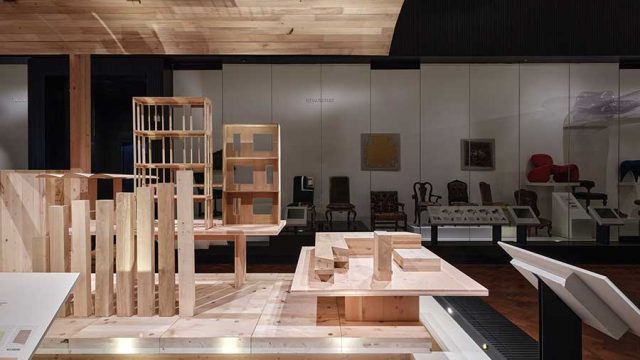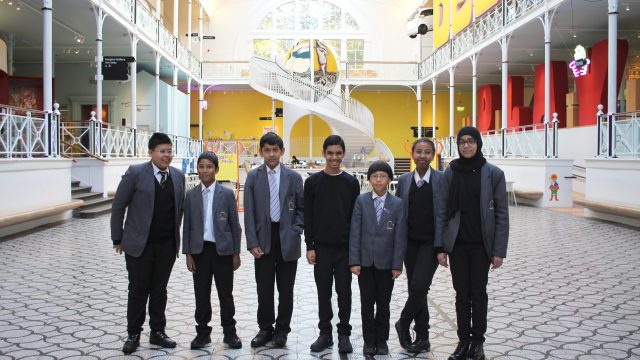In this conversation, Anna Talley and Denise Lai reflect on their time as volunteers in the Design, Architecture & Digital department for the ‘Design: 1900 – Now’ gallery project. Anna and Denise are both graduates of the V&A/RCA MA History of Design programme.

Anna Talley: So, what surprised you about working within the Design, Architecture & Digital (DAD) department?
Denise Lai: I think, for me, it was the breadth and the scope of the department – the blend of high and low culture and being able to explore different geographies, periods and object types. I think it’s still rare to have that kind of approach to collecting, where every aspect of society can be unpacked, and you can think about design and why it matters. How about you, what do you think?
AT: I was surprised by the cutting-edge approach to contemporary content, especially with their Rapid Response Collecting. Rapid Response is such a special part of what DAD does that separates it from other departments, both within the museum and around the world. The seriousness with which they approach large amounts of contemporary material soon after its creation, evaluating its cultural impact in the present and the future and then being able to collect it through special channels in the department, is very cool. Especially because it makes the collections objects more relatable to contemporary audiences.
DL: That’s so true, because I feel like it’s one of the very few museum galleries that I can go to in the UK where I can actually relate to the objects that I see. Also, I feel it’s significant because that kind of variety is exactly how we consume information in the digital age. We’re constantly flicking through different things and, in my own research, I definitely still struggle to find my ‘niche’ because I’m drawn to so many different elements of contemporary design and culture. There’s also the fact that the department’s scope definitely validates me bingeing Keeping Up With The Kardashians as some sort of intellectual activity. It’s definitely not good for my hoarding tendencies, either. I don’t know about you, but I can’t stop analysing objects through the lens of design!

AT: No, I know! Especially digital stuff – I pay so much more attention now to things like NFT’s as a possible museum-quality collectible object. DAD has set themselves out for a pretty broad range of material. If you’re studying 18th or 19th century furniture, there’s a finite amount of material from that period, whereas when you’re doing contemporary collecting and the world is outputting information at exponentially higher levels than 100 years ago, then the amount of material that you’ve now set out to be responsible for as the curatorial department is just unfathomable. So, it’s pretty wild to be responsible for deciding, out of all of this material, what is actually going to be important 100 or 500 years from now.
DL: Yeah, so true. Were any of the objects that you researched particularly important to you?
AT: I researched the Alphafly trainers – they’re these trainers designed by Nike that were worn as a prototype by Eliud Kipchoge when he ran the first sub-two-hour marathon. I was recovering from a running injury during COVID, so I think on a personal level, I became interested in the object because I was looking at a lot of running shoes, trying to figure out what was going to be best for my injury. I had never thought before about how carefully biomechanics are considered in the construction of sportswear – down to the chemical structures of the foam in the bottom of the shoe that makes it really light and responsive to pressure. I think it’s a really great example of how design can serve to enhance human mobility. We’ve seen this through history, design’s ability to enhance human capacities beyond our natural state, like an appendage, but I had never thought of sportswear in that way before. What’s yours, are you going to talk about the Kim Kardashian book?

DL: No, I never actually got to research it! I was really looking forward to the email asking me to write about Selfish, but sadly it never came. Jasleen Kaur’s Tala Curry Measure grew on me in a surprising way. It’s a cook’s measure designed to give measurements for dry ingredients without having to use a scale, which the artist had repurposed to provide recipes for curry dishes. Her idea was to encourage thinking about measurements in cooking as an intuitive practice, rather than in millilitres and grams, in the same way she was taught to cook-by-eye by her Indian family. I suppose it didn’t really stick with me at first because my culinary skills are abysmal. But two months ago, I went to an exhibition called The Size of Rice by the artist Mella Jaarsma at A+ Works of Art Gallery in Kuala Lumpur, and the implications of thinking about measurements in this way became a lot clearer to me. Jaarsma’s exhibition, like Kaur’s measuring cup, explored the alternative measurements you find in Asian cultures, taking inspiration from the use of rice as a system of measurement in Southeast Asian agrarian culture. Building from that, Jaarsma also explored other alternative measurements like the Asta Kosala Kosali practice of Balinese architecture whereby the proportions of the home are measured in relation to the body parts of its owners: their arm spans, the length of your feet, the circling of your fist. Thinking about this in combination with Kaur’s curry measure really opened up a new awareness of my body and its actions: the muscle memory it retains from inherited daily rituals and activities, and in turn how different it might feel if all our everyday objects and spaces were tailored to our bodies and practices. Instead, we have to squish ourselves into these janky forms because some designer claimed them to be somehow universally applicable to everyone [gestures to her ‘ergonomic’ office chair that gives her back pains].

AT: It’s funny that we both picked objects that had something to do with the body’s direct relationship to an object.
DL: That’s true, maybe it has to do with our hypersensitivity to everything in our immediate physical environment in the lockdown.
AT: Okay, so hypothetically, if you were leading on acquiring objects for the first rotation of the gallery, what would you be focusing on?
DL: For me, I’d be most keen to look at the Rapid Response Collecting rotations. I’d definitely try to inject some of the exciting designs coming out of the Malaysian contemporary design scene. Recently, I’ve been researching works by the architects, No-to-scale* studio, who made a series of digital collages in 2019 responding to our biggest corruption scandal in Malaysia, 1MDB. Inspired by the superyacht that was supposedly purchased with stolen funds from the 1MDB sovereign wealth fund for private use, the designers created a speculative proposal to dock the aforementioned yacht as the Malaysian pavilion at the Dubai Expo in 2020. Their goal was to critique the rampant practice of corruption in Malaysia, at the same time using the medium’s cut-and-paste techniques to draw together and thus make sense of the extent of money and material excess involved in the scandal. I think the collages would fit with the RRC’s journalistic sensibility, and show the global legacy of collage-based work, which started in the sixties. Anyway, throwing the question back at you.

AT: My first thought is not so specific, but more broadly to make it something that is relatable to the ‘local’ people within Greater London. In the past year, there’s been so much focus on trying to reach out to local audiences, which is a good challenge for the V&A because so much of its audience is international. One of the things that the pandemic taught us was how to network with other museums and communities that are close by. So, how might you approach places like The Museum of the Home or other arts organisations that are further east and work with them to look at the material they were collecting during the pandemic and create a display that would attract visitors from all over the city. Anyway, has the experience working with the V&A influenced what you’d like to pursue in the future?
DL: Going back to what I said earlier, I’ve always tried to find a niche in my research, but my restlessness doesn’t lend well to that goal. So, in a way, having worked in this department was a sort of reassurance that there are arts careers out there where you can productively explore a broader definition of design and society. Not in a generalising way either, but with an approach that demonstrates how you can draw productive links between seemingly disparate objects that, when placed together, can open up new and often unexpected narratives in design. How about you?
AT: That’s a really good point! For me, one thing that I became interested in was learning to be really critical in your research. So, not only critical in terms of re-evaluating existing objects in the collection as time goes on, which I think is important, but also in relation to contemporary collecting. As a DAD curator, you’re acting as a kind of cultural critic as well as a curator when you’re selecting which objects to bring in the museum. And because of that, you then have to have a pretty broad knowledge of what is going on in contemporary culture. You don’t have the luxury of being able to look back and situate an object – you have to situate an object in the culture as it’s happening. As somebody who is pretty restless and likes listening to podcasts and reading books and magazines and Twitter, being able to work somewhere where I can satisfy all my interests in culture, outside of the particular thing that I’m researching, I think will definitely influence the kind of material that I’d like to work with moving forward.
DL: While we’re on the topic of restlessness, Matthew Bevis’ essay In Search of Distraction was so helpful for me in drawing out the benefits of this feeling: he focuses on the productive moments that happen when you’re distracted, and the alternative and ultimately creative ways of thinking that emerge when you’re in that state of mind. And I think that’s relevant to the why the new gallery is so significant, especially in their focus on consumption and with objects like the Supreme Metrocards that are designed as products that generate hype and cultural significance, but not explicitly for a great amount of time. Many of these contemporary objects don’t ask you to think that deeply about their designs, but this gallery now offers us a chance to dwell on their goal to distract you and to try to understand the histories they generate through their brief but ultimately significant reception.

AT: Yeah, that’s an interesting point. It’s like critically evaluating the things that are supposed to be distracting us, turning the distraction on its head. It’s like, you thought you had us –
DL: Yeah, but we’re going to write a two-page research essay on it.
AT: As a final question, what skills have you honed or developed from this experience, besides being able to expand 150 characters to dissertating on a popular culture topic?
DL: I think writing public access descriptions for object catalogues (these are the descriptions of objects you’ll find on Explore the Collections object records) was a really useful lesson in what kinds of vocabulary and descriptive language you should be using when writing for a global audience. With the kinds of objects that the DAD department collects, it also becomes a lesson on what language you use to talk about sensitive topics in an objective way. All of this has been really helpful for my current archiving project where I’ve had to create my own organising systems, so having been pushed to think about the language and categories of archiving has been invaluable.
AT: It’s one thing to talk about an object in itself and another to talk about an object in its wider context. As somebody who writes about design and culture, deciding how much of that context to include and how much to leave out is pretty hard, even harder than learning CMS (the Collections Management System that the museum uses to document each object), which is really difficult! The ultimately subjective decisions you have to make about the story you are telling about an object is a skill you’re constantly honing. So, that is something I have had to learn a lot more about, and especially with DAD, particularly when writing up acquisition justifications. It’s made me a better researcher and editor.
Maybe also working at home, maybe that’s a skill.
DL: I’m going to go watch some Real Housewives now.
AT: Okay I’m going to take the dog for a walk.
Anna Talley is a writer and researcher interested in modern and contemporary design. Her work has been published in Design Observer, AIGA’s Eye on Design, and the New York Review of Architecture. Anna is also co-founder of Design in Quarantine, an online archive of design responses to the COVID-19 pandemic and Online Editor for the Design Research Society. In September 2021, she will be starting a PhD in Design at the University of Edinburgh.
Denise Lai is now based in Kuala Lumpur, where she is currently working as the sole archivist on a project to catalogue and digitise the collection of the Malaysian contemporary artist, Wong Hoy Cheong. Prior to this, she was responsible for co-founding the Malaysia Design Archive’s Wawasan 2020 collection, for which she was awarded the Design History Society Virtual Student Award in 2020. Building off of this research, she is now co-curating an exhibition entitled Wawasan.directory, which aims to expand the archive to present a series of speculative histories and alternative futures in and out of the Malaysian development programme. The exhibition is set to launch online in August 2021.


